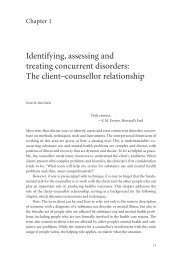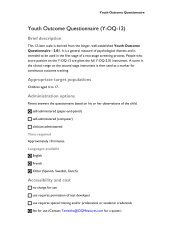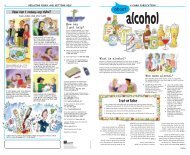Clinical Supervision Handbook - CAMH Knowledge Exchange ...
Clinical Supervision Handbook - CAMH Knowledge Exchange ...
Clinical Supervision Handbook - CAMH Knowledge Exchange ...
Create successful ePaper yourself
Turn your PDF publications into a flip-book with our unique Google optimized e-Paper software.
<strong>Clinical</strong> <strong>Supervision</strong> <strong>Handbook</strong><br />
and trying to engage her around non-illness related topics—getting<br />
to know her as a person, her hopes, her dreams, her interests,<br />
her past and so on.<br />
For the next four weeks, the nurse did this. When the clinical<br />
supervisor met with the nurse again she described the process<br />
and outcome. The client chose the coffee shop and they made a<br />
point of going there to “chat” at least once a week. The nurse<br />
refrained from discussing the client’s illness during these outings,<br />
and instead explored topics of interest to her client—they talked<br />
about what her life was like before she became ill, how she liked<br />
to dress and wear her hair; and her dream to work as a hair stylist.<br />
These outings to the coffee shop became important to the client<br />
and she looked forward to them. The nurse noticed that over the<br />
course of the next four weeks, her client became much less defensive<br />
with her on the unit, and more relaxed. She started to pay<br />
more attention to her dress and her appearance. Eventually she<br />
was receptive to the nurse addressing her illness issues again.<br />
When the client was discharged from the hospital she gave the<br />
nurse a coffee mug. The clinical supervisor and nurse discussed the<br />
significance of this, an affirmation that these trips to the<br />
coffee shop had been meaningful to the client and had contributed<br />
significantly to them working together therapeutically to<br />
achieve a positive outcome.<br />
This clinical situation highlighted for the nurse the limits of her<br />
role and resulted in her understanding more clearly that she<br />
could not “control” the client. By taking a holistic approach to the<br />
client, getting to know her beyond the illness, she communicated<br />
respect for her client as a person, understanding and a hopefulness<br />
that facilitated the therapeutic relationship and contributed<br />
to the client’s recovery. This example demonstrates how concepts<br />
such as holistic care, empathy and recovery are woven into the<br />
supervisory process. For the nurse, these concepts are brought to<br />
life and more deeply understood as they are experienced in the<br />
context of a real therapeutic relationship.<br />
58

















